Mastering Off-White: 10 Timeless Decor Ideas to Elevate Your Home
Decorating a home is a deeply personal and transformative experience, and few elements offer as much potential as color. While pure white can sometimes feel stark, off-white paint colors emerge as true game-changers, possessing an uncanny ability to redefine the ambiance and aesthetic of any room or entire house. These sophisticated shades are not merely “almost white”; they are nuanced hues with subtle undertones that distinguish them from a crisp, unadulterated white. Think of the soft warmth of cream, the subtle richness of eggshell, the classic elegance of ivory, or the inviting glow of vanilla. Each offers a unique character, providing a versatile foundation for a myriad of interior design styles.
Unlike pure white, which often has a distinct hex code, off-white shades derive their unique qualities from these complex undertones—be it a hint of yellow, a touch of gray, a whisper of beige, or even a subtle pink or green. This inherent versatility makes them a favorite among interior designers and homeowners alike. They provide a clean, expansive backdrop while injecting warmth, depth, and a touch of sophistication that pure white sometimes lacks. When thoughtfully applied, off-white can create an atmosphere that feels both fresh and inviting, modern and timeless. Below, we explore ten inspiring ways to incorporate these beautiful off-white paint colors and design elements into your interiors, ensuring your home feels refreshed, refined, and utterly captivating.
1. The Art of the Classic Off-White Door
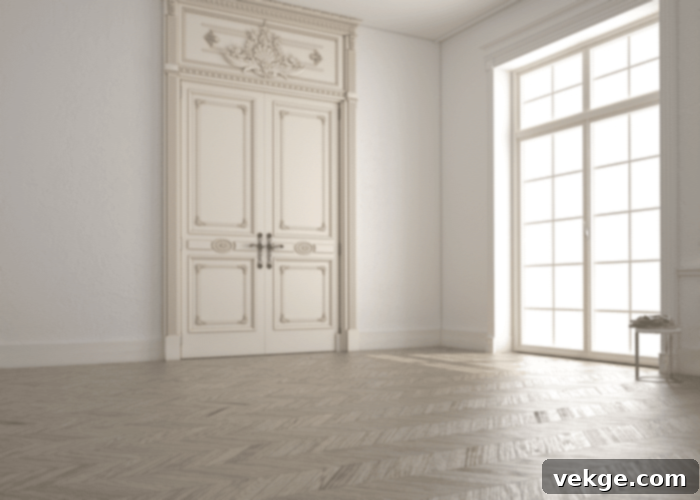
Introducing a classic off-white door can profoundly impact the perception of a room, especially when the surrounding walls are also painted in a similar off-white hue. The key to making this work is to ensure a subtle yet discernible difference in the undertones or contrast between the door and the wall color. For instance, if your walls lean towards a warmer off-white with yellow undertones, opt for a door with slightly cooler gray or greige undertones, or perhaps a creamier off-white if the walls are a softer ivory. This deliberate variation prevents the door from blending seamlessly into the wall, avoiding a flat, camouflaged appearance. Instead, it creates a more defined architectural element, adding visual interest and depth to the space. Consider also the finish of the paint—a slight sheen difference (e.g., eggshell for walls, semi-gloss for doors) can further enhance this distinction, reflecting light differently and highlighting the door’s form. This simple yet sophisticated trick elevates the overall aesthetic, making the entryway or interior passage feel more thoughtfully designed and polished.
2. Embracing a Serene Cream Theme
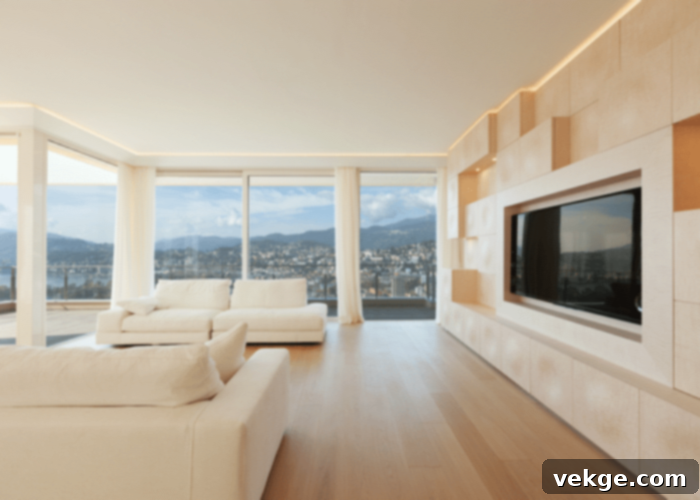
While a cream theme might sound straightforward, its execution can result in an exceptionally classy and inviting atmosphere. Cream, as a warm off-white, naturally lends itself to creating a serene, harmonious, and sophisticated space. To fully embrace this theme, integrate cream across various interior elements. Start with the wall color, choosing a rich cream that brightens without feeling stark. Then, extend this palette to textiles—think plush cream rugs, elegant drapes, and soft throws. Furnishings in complementary light wood tones or upholstered in cream-colored fabrics will further enhance the cohesive look. Accessories, such as ceramic vases, decorative trays, and artwork featuring warm, muted tones, will tie the room together. Remember that texture is paramount in a monochromatic or limited color scheme; layer different textures like linen, wool, velvet, and natural fibers to add depth and prevent the space from feeling flat. Furthermore, lighting plays an absolutely critical role in any cream-themed room. Warm, diffused lighting will enhance the cream’s natural glow, making the space feel cozy and welcoming, while harsh, cool lighting can diminish its warmth. Thoughtful lighting design ensures the cream theme shines in all its sophisticated glory.
3. The Refreshing Addition of Green Plants
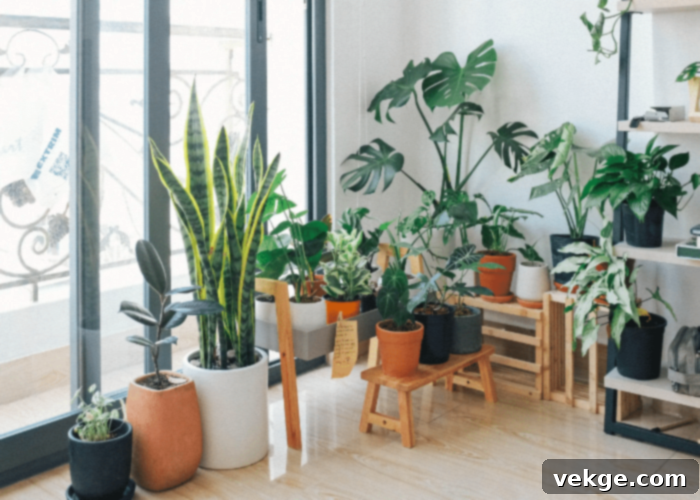
Introducing living plants into an off-white space is an effective way to infuse life, natural color, and a refreshing touch of nature. The vibrant greens of foliage beautifully contrast with the soft neutrality of off-white walls, creating a dynamic yet calming aesthetic. Beyond their visual appeal, plants contribute to a healthier indoor environment by purifying the air and boosting mood, aligning with the principles of biophilic design. When selecting plants, consider varieties that thrive in indoor conditions, such as snake plants, ZZ plants, Pothos, or Monstera for their striking leaves. For larger spaces, a tall fiddle-leaf fig or an olive tree can serve as a stunning focal point. After bringing them home, remember to provide them with the specific care they require: adequate natural light (some prefer bright, indirect light, others can tolerate lower light), appropriate humidity levels, and consistent maintenance, including regular watering, dusting leaves, and occasional fertilizing. The choice of planter also matters; natural materials like terracotta, ceramic, or woven baskets can enhance the organic feel, complementing the off-white backdrop and bringing an extra layer of texture and style to your home.
4. Crafting a Focused Off-White Study

Designing a study or home office with an off-white paint color provides an ideal foundation for productivity and focus. The clean, neutral backdrop minimizes distractions, creating a calm and expansive environment conducive to deep work, creative thinking, or academic pursuits. When decorating an off-white study, balance is key to prevent the space from feeling sterile. Introduce furniture in warm wood tones (like oak or walnut) or natural materials to add an organic touch. Ergonomic chairs in a complementary neutral (such as a soft gray or beige) can blend seamlessly while ensuring comfort. Strategic lighting is crucial: combine ambient lighting for overall illumination with task lighting at your desk to reduce eye strain. Incorporate subtle pops of color through desk accessories, framed artwork, or a small plant to add personality without overwhelming the tranquil palette. Shelving can be kept tidy with stylish storage boxes. The goal is to create an organized, inviting, and quiet sanctuary where you can concentrate effectively, making the most of the inherent peacefulness that off-white provides.
5. Enhancing Comfort with Diverse Cushions
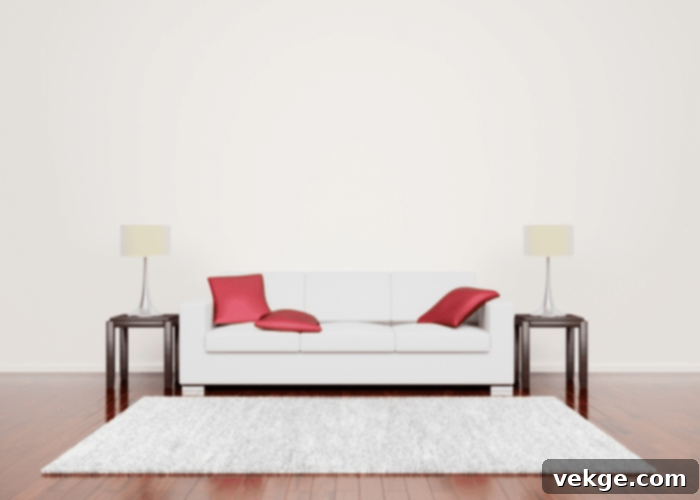
Cushions are more than just decorative accents; they are essential for adding layers of comfort, texture, and personality to any space, particularly one dominated by off-white tones. When choosing cushions, select colors, patterns, and fabrics that harmonize with the room’s overall vibe, aesthetic, and existing decor. For a monochromatic off-white scheme, opt for cushions in varying shades of cream, beige, or light gray, playing with different textures like knit, velvet, or linen to add visual interest. If you want to introduce a splash of color, choose hues that complement the undertones of your off-white walls. For instance, cool off-whites pair well with blues and greens, while warmer off-whites look stunning with terracotta, mustard, or maroon. Cushions can be artfully arranged on sofas, armchairs, or beds to create inviting vignettes. Don’t shy away from mixing sizes and shapes—a combination of standard squares, long lumbar cushions, and round ones can create a dynamic arrangement. Moreover, a large, supportive back cushion on a chair or bed can offer invaluable comfort, transforming a simple seating area into a cozy retreat, making it nothing less than a blessing for your back and an instant upgrade to your home’s comfort factor.
6. The Bold and Classy Combination: Off-White with Strong Accents
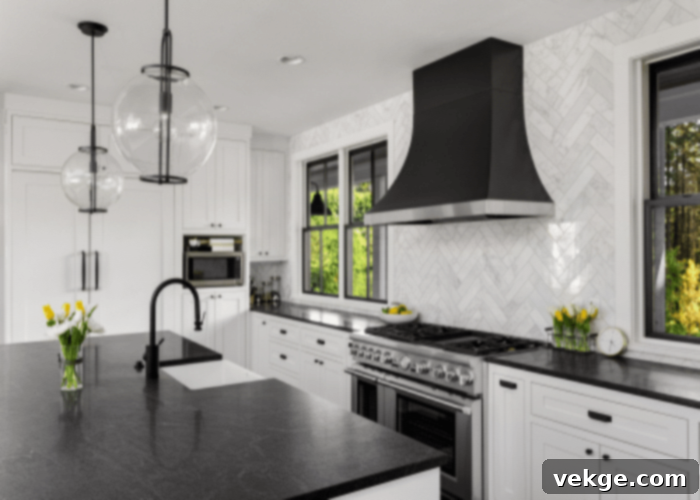
Creating a space that feels both bold and classy with off-white as the base requires a thoughtful and strategic selection of colors, textures, and designs. The off-white walls provide a perfect canvas, allowing more assertive elements to truly shine without overwhelming the senses. To achieve this sophisticated balance, maintain a largely minimalistic approach with the off-white elements, then introduce bold accents in measured doses. Consider incorporating neutral tones with strong characteristics, such as deep charcoal gray, rich espresso brown, or even black, in your furniture or significant decor pieces. A striking piece of contemporary art with vibrant colors against an off-white wall can provide a powerful focal point. Introduce bold textures through a geometric rug, a statement light fixture in a metallic finish, or accent furniture with unique silhouettes. The essence of this combination lies in careful balancing: ensure that the boldness is expressed through intentional, high-quality pieces, while the classiness is maintained through the harmonious integration of these elements within the serene off-white framework. It’s about making a statement without sacrificing elegance, creating a space that feels both dynamic and refined.
7. A Royal Touch: Little Dash of Maroon Color
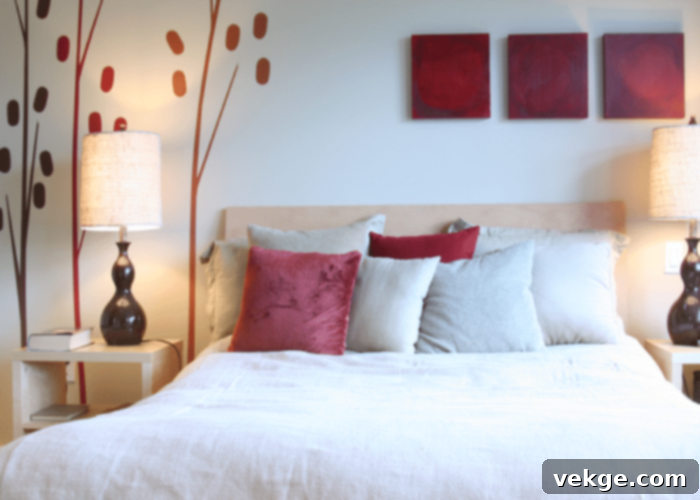
For those aspiring to infuse a sense of royalty and opulence into their living space, a little dash of maroon color paired with off-white is an exceptional choice. Maroon, a deep and rich shade of red, inherently conveys luxury, warmth, and a historical grandeur, making it a perfect complement to the understated elegance of off-white. This combination works beautifully in various rooms, particularly bedrooms and formal living areas, where a regal atmosphere is desired. Imagine off-white walls serving as a pristine backdrop, allowing maroon accents to command attention. You can introduce this majestic color through plush velvet throw pillows, a rich patterned rug, opulent drapes, or even a statement armchair upholstered in a deep maroon fabric. Artwork featuring maroon hues can also tie the theme together. The richness of off-white provides a soft, sophisticated canvas, while the royalty of maroon injects depth, passion, and a luxurious feel. This pairing not only highlights your exquisite taste in color but also creates an interior that feels both grand and inviting, a true testament to timeless design.
8. The Timeless Off-White and Gray Combination
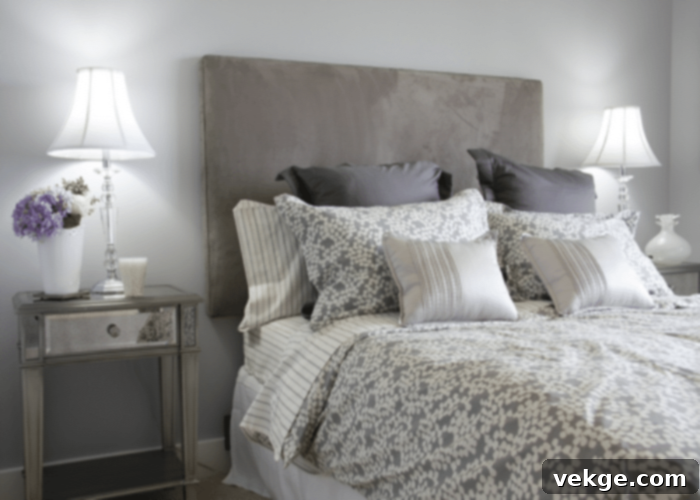
The pairing of off-white and gray is an iconic combination revered in interior design for its ability to create a truly transformative effect on any room. This sophisticated duo effortlessly blends the soothing quality of off-white with the rich, calming, and grounding effects of gray, resulting in an aesthetic that is both timeless and elegantly modern. The beauty of this combination lies in its versatility; it can lean towards cool and minimalist with light grays and cooler off-whites, or become warm and cozy with deeper charcoal grays and creamy off-whites. Consider off-white walls providing an expansive feel, complemented by gray furniture such as a sofa, accent chairs, or a rug. You can introduce various shades of gray through textiles, artwork, or decorative objects to add depth and dimension. This combination is particularly effective in creating a serene and balanced environment, promoting a sense of peace and tranquility. It guarantees a calming effect, not just for your eyes, but also for your soul, making it a perfect choice for living rooms, bedrooms, and even home offices where a peaceful ambiance is paramount.
9. Inviting Warmth with Wooden Elements

Incorporating wooden elements into a space adorned with off-white paint colors is a proven method for creating a warm, inviting, and grounded atmosphere. Wood, with its natural textures and varied tones, provides an organic contrast to the soft neutrality of off-white, adding visual interest, depth, and a touch of rustic charm or sophisticated elegance, depending on the type and finish. Consider introducing wooden works through furniture pieces like a sturdy dining table, elegant sideboards, or a statement headboard in the bedroom. Flooring made of hardwood or engineered wood can immediately warm up a room. For architectural detail, exposed wooden beams or paneled accent walls can become stunning focal points. Even smaller decorative items like wooden bowls, frames, or sculptures can contribute to the overall aesthetic. The key is to balance these wooden elements with the off-white paint colors and other decor items in the room. A light, airy off-white might pair beautifully with light-toned woods like maple or birch for a Scandinavian feel, while a warmer cream off-white could complement richer woods like walnut or cherry for a more traditional or luxurious look. This thoughtful integration ensures a harmonious and cohesive design that feels both natural and refined.
10. Embracing Nostalgia: Giving Vintage Vibes
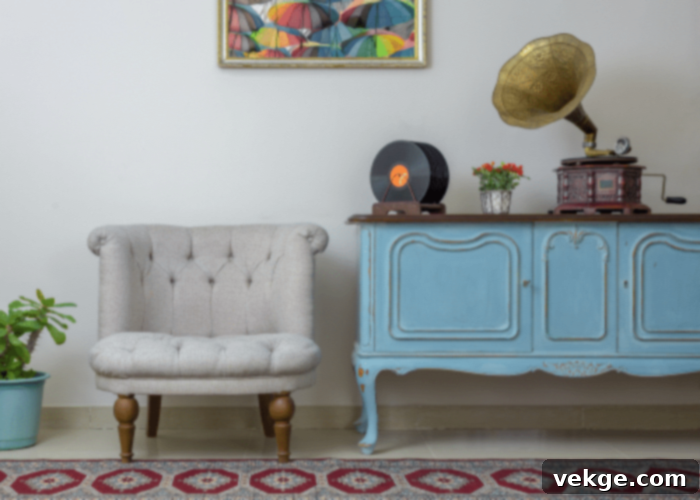
The trend of incorporating vintage vibes into home decor is currently thriving, offering a unique blend of history, charm, and character that significantly enhances a space’s aesthetic appeal. Off-white provides an exceptional canvas for this style, allowing vintage elements to stand out and tell their story without competing with bold wall colors. To achieve a captivating vintage look, you can meticulously curate various elements. Start with furniture; antique dressers, distressed armoires, or mid-century modern pieces can instantly ground the room in a bygone era. Wall decor can include ornate gold-framed mirrors, vintage botanical prints, or classic landscape paintings. Incorporate textiles with historical patterns, such as toile, chintz, or damask, in drapes, upholstery, or throw blankets. Even smaller accessories like an old rotary phone, a retro radio, or a collection of antique books can add authentic touches. Consider architectural details like decorative crown molding, wainscoting, or even vintage-inspired wallpaper with subtle patterns. The beauty of off-white walls in this context is their ability to brighten the space and allow these cherished vintage finds to truly shine, creating an inviting and personality-rich interior that feels both nostalgic and utterly chic. It’s about blending the old with the new in a way that feels cohesive and beautifully lived-in.
Conclusion: The Enduring Charm of Off-White
In conclusion, off-white paint colors are far more than just a safe choice; they are a truly exceptional addition to your interiors, offering unparalleled beauty, versatility, and timeless appeal. Their subtle nuances and varying undertones provide a sophisticated backdrop that can adapt to virtually any design aesthetic, from modern minimalist to classic opulent, and from cozy farmhouse to bold contemporary. They possess the unique ability to make spaces feel larger, brighter, and more inviting, creating a sense of calm and refinement that pure white often struggles to achieve.
Before committing to any specific shade, remember a few crucial tips to ensure the perfect outcome: always test samples directly on your walls, observing how the color appears under different lighting conditions throughout the day. Consider seeking expert advice from an interior designer or paint consultant, especially if you’re unsure about undertones. Most importantly, evaluate how the chosen off-white complements your existing furniture, artwork, and decor items. Think about how the paint interacts with both natural light streaming in through windows and the artificial lighting in your home, as this will significantly impact its perceived warmth and depth. By embracing off-white, you’re not just choosing a color; you’re investing in a foundation for a beautiful, enduring, and effortlessly elegant home.
Which of these inspiring off-white paint color ideas resonates most with your personal style? We’d love to hear your favorite approach to decorating with off-white in the comment section below!
Frequently Asked Questions About Off-White Interiors
How Does Off-White Look?
Off-white is characterized by its subtle deviation from pure, stark white. It typically incorporates faint undertones of other colors, such as beige, gray, yellow, pink, or even green. This makes it a wonderfully nuanced and versatile color that has earned its place as a favorite among designers. Depending on its undertones, off-white can appear warm and creamy, cool and crisp, or soft and ethereal. It often has a muted, sophisticated quality that helps create a softer, less clinical look than bright white. While incredibly adaptable, it shines particularly well on paneled walls, ceilings, and as the primary wall color throughout a home, offering an expansive yet comfortable feel.
What Is a Common Alternate Name for Off-White?
One of the most widely recognized alternate names for a type of off-white is “ivory.” Ivory is a creamy, slightly yellowish-white color, reminiscent of the material derived from animal tusks and teeth. Historically, ivory has been associated with luxury and sophistication. Interestingly, the color ivory gained formal recognition as a distinct shade and was integrated into the English language as a color term as early as 1385, highlighting its long-standing presence and appreciation in art and design. Other terms like “eggshell,” “cream,” or “vanilla” also describe specific variations of off-white.
Is Off-White Still a Popular Trend?
Despite evolving design trends, off-white has consistently maintained its position at the forefront of popular interior design choices, proving its enduring appeal. Its continued popularity stems from its inherent characteristics: unparalleled versatility, allowing it to seamlessly integrate with diverse styles and color palettes; diversity, encompassing a wide range of undertones that offer unique moods; and its undeniable timelessness. Off-white is not merely a fleeting trend but a foundational staple that provides a sense of calm, elegance, and spaciousness. You can confidently choose an off-white palette with the assurance that it will deliver fantastic, lasting results and provide a beautiful, sophisticated backdrop for years to come.
What Makes Off-White Special Compared to Other Colors?
What sets off-white apart from many other colors is its unique ability to offer a softer, more welcoming, and more enveloping personality than a stark, pure white. While bright white can sometimes feel cold or clinical, off-white introduces a gentle warmth and subtle depth that helps set the tone for a truly cozy and comfortable home environment. It acts as a serene canvas, allowing other design elements—be it furniture, artwork, or textiles—to truly stand out without overwhelming the space. This inherent softness and welcoming nature make off-white a perennial go-to and often the first choice for countless homeowners and designers looking to create inviting, sophisticated, and harmonious interiors.
